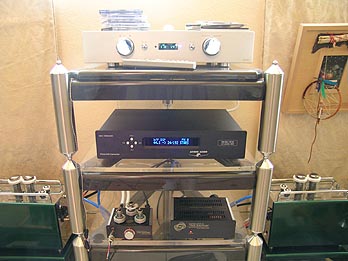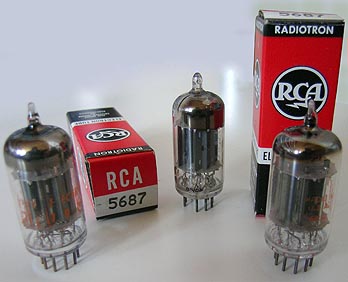|
This review page is supported in part by the sponsor whose ad is displayed above
|
|||||||||||
 |
|||||||||||
| Though it seems impossible, the Raptor and K-1000s did indeed get along famously. True, the amp began to distort in the bass between 2:00 and 2:30. For my ears however, that was simply too bloody loud. I listened at about 12:30 - 1:00 o'clock at robust levels and at high noon for long-term volumes. The 5687s exhibit surprising potency even into these notoriously inefficient, open-backed and wigged-out/winged-out earspeakers. There's no lack of tonal color, no malnourished bleaching, no fuzziness around the edges. Bass is naturally not as powerful and articulated as over the current-drive FirstWatt F1 with its 10 watts of transistor muscle. That minus gets emphasized when you toe out the AKGs. In this department, the Raptor is merely middle of the road, not outstanding. However, bass freaks in general do not feel drawn to the K-1000s for the obvious reasons. Hence the Raptor's relative lightness here when paired with this counter-intuitive load is simply par for the course. The true test in my book really was tonal balance and harmonic density. Here the Raptor aced the test with flying colors. Simply put, the AKGs suffer an innate imbalance especially with the stock wiring that makes everything above the upper midrange zippy and excessively energetic. Stefan AudioArt's replacement cable essentially redresses the balance. Still, you need to exercise caution and adeptness what to mate these 'phones to. Ray's Neutrik-to-1/4"-plug extension used the Austrian's dastardly stock wiring and still the anticipated brightness didn't rear its head. Impressive! |
|||||||||||
 |
|||||||||||
If the AKG's are your main headphone squeeze and your source outputs the standard 2 volts, I would not recommend the Raptor simply because listeners even with high hearing sensitivities will eventually run into distortion with classical recordings whose median level is excessively low to reserve the requisite headroom for the violent dynamic peaks. On the other hand, should the Ks be merely one of a group of headphones you keep around to season to taste and mood, I would strongly recommend the Raptor as the all-in-one solution for the crew. You'd simply grab a Grado, Sennheiser, Beyer or audio-technica for boombastic hit-you-in-the-grey-matter bass orgies or the occasional indulgence into large-scale classical. For everything else, the Raptor/AKG combo is peachy without reservations. And that more than anything else is testament to the drive and current capabilities of the 5687s. Trust me, unless you've heard the K-1000s powered from a current-source amplifier, you haven't heard precision and articulation yet. In other words, it's current they thrive on, not mondo power. While no Nelson Pass amp, Ray's Raptor delivers more current than is usual for an amp with small-signal valves. And that's likely why --into the loads it's really designed for -- it exhibits the dynamics and overall neutrality it does. Bloom sometimes isn't just a function of THD but also a lack of grip. Insufficient control translates as a certain looseness and softness. That's anathema for the Raptor. It's why it exhibits a modicum of harmonic warmth but zero bloom. |
|||||||||||
 |
|||||||||||
| I also inserted the Raptor into my big rig where it was driven from the Accustic Arts Drive 1/Audio Aero Prim SE combo and Stealth Indra interconnects. While this was a financial mismatch of the worst kind, it proved a few things. First, this amp won't be a bottle neck when resolution goes up. Despite using tubes, the noise floor is so low that what goes in comes out even if its $10,000 worth of ultra rez spinning a truly superior recording like Bob Ravenscroft's Three Alone [Ravenswave 9002], an SACD hybrid of piano trio pressed into my greasy mitts at HE2005 and as good as recordings get. Two, even set to its 5-volt maximum output level, the Audio Aero DAC/pre did not overload the Raptor. Fascinating. K-1000 headbangers can thus cheat and build in more headroom with higher-than-standard source outputs. | |||||||||||
 |
|||||||||||
| Time to roll tubes. Ray had included 2 x RCA 5687s and one Mullard 12AU7. The stock GE 12AU7 was a little meatier than the Mullard, a little denser whereas the Mull especially on vocals was a skoch more focused and slightly more forward. The stock Philips 5687s had more tone than the leaner RCAs which allowed for two very similar outcomes: GE/RCA vs. Mullard/Philips. In my book, why listen to a valve amp and then voice it to extinguish the heat? However, those so inclined could exorcise the mild thermionic straits with a canny selection of tubes. I'm equally sure that were you to lean in the opposite direction, you could push things into a slightly more voluptuous direction as well. Personally, I preferred the subtle voicing of the stock tubes. It elicited just the right amount of body and harmonic substance without curtailing dynamics and jump factor. | |||||||||||
While I did not think that Ray's Stealth was it when used as a dedicated headphone amp, the Raptor is most definitely it. Unlike the octal 6SN7 used by SinglePower -- and currently making an appearance in Taos by way of Vu Hoang's Deja Vu preamp -- the 5687 does not possess the same level of tonal saturation and hence packs less aural heat (though it physically gets very toasty). Tone-über-alles components can minimize distinctions between recordings due to additive colorations. Ray's sonic credo is squarely focused on highlighting rather than minimizing those differences and that's what the Raptor does. It's a resolution machine that doesn't walk the high-noon beat to become stark and brutal but borrows just enough vibrancy from its tubes to do tone without transitioning into monster-tone territory. Neutrality can have the irritating habit of becoming boring and uninvolving real fast. Mr. Samuels has here found the perfect balance. The Raptor is robust and solid, fast and transparent, with that necessary minimal bow to warmth to avoid hardness. It exhibits excellent control over its transducers, making for precision that's not hyped but simply a function of proper current. This is audible in transient clarity as well as fully visible bass all the way into the abyss. Vocals have just a blush of tube magic while the treble avoids harshness just as you'd expect from valves. It's perhaps ever so slightly tamed or polished off around the edges but definitely simpatico with having loudspeakers hover directly atop your own membranes. In short, the Raptor is a true statement valve product with no weaknesses and a very subtle voice that primarily taps into the tube repertoire with microdynamics, speed and soundstaging, very selectively with timbral development and not at all with any of the old-timey notions. The core motto here is "finesse meets brass cojones". |
|||||||||||
 |
|||||||||||
| Second opinion: Headfier Ryan Clarin contacted me after this review's first page went live as an intro. He had penned a consumer review on the Raptor and was eager to share notes. Reading his findings on HeadFi mirrored my own to a very high degree and Jude, HeadFi's owner, gave his kind permission to 'syndicate' Ryan's write-up as a second opinion following my own descriptions. Consequently, Ryan just earned his moonman badge and has been elected as our resident headphone maniac who will concentrate on cans and the amps built for them. The next page covers his review as originally posted on HeadFi, albeit edited for brevity by removing those sections that dealt with the usual product descriptions we've already covered. |
|||||||||||
 |
 |
||||||||||
 |
|||||||||||